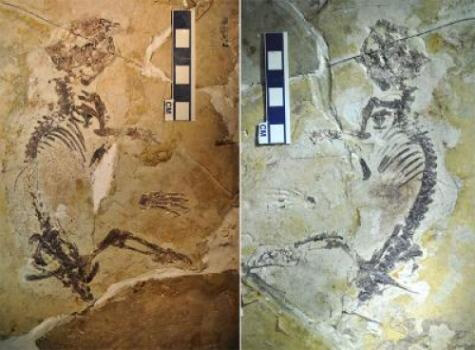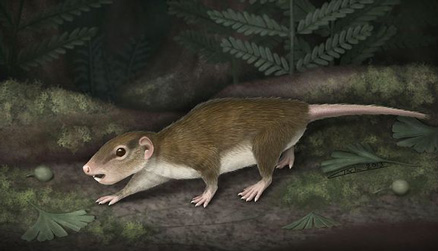Earliest Complete Fossil of a Multituberculate Found
The Mesozoic might be referred to as the “Age of Reptiles” but scurrying around the dinosaurs was a very wide variety of early mammals, descendants of which are familiar to us as placentals, monotremes or marsupials. The problem with studying primitive mammal fossils from the Mesozoic is that for much of the time when dinosaurs roamed, mammals remained small and their delicate, light bones did not fossilise well. The study of early mammal specimens is exceptionally difficult due to the paucity of fossil remains.
Multituberculate Mammal
Any small mammal that died, was likely to be scavenged long before fossilisation could possibly take place. Much of what we know about Jurassic and Cretaceous mammals, for example, comes from the study of faecal remains (coprolites). Indeed, many mammals lived in environments where fossilisation was very unlikely to occur.
The remains of mammals either hunted and killed or scavenged would sometimes be left in droppings and these could perhaps fossilise thus preserving the undigested remains of the animal. The fossil record of small mammals is thus made up mostly of fragments of jawbones, and teeth and it is from these tiny remains that palaeontologists have been able to piece together the story of mammalian evolution.
Chinese Fossil
However, a team of researchers writing in the academic journal “Science” have published a report on a 160-million-year-old fossil multituberculate, found in China. This is one of the earliest examples of a multituberculate mammal known to science and indicates that these small, chisel-teethed creatures existed for over 125 million years, making them the most successful mammalian group in terms of longevity.
The New Fossil Discovery (Rugosodon eurasiaticus)
Picture credit: University of Chicago and Chinese Academy of Sciences
Rugosodon eurasiaticus
The fossil of Rugosodon eurasiaticus is preserved in two shale slabs in part (left) and counterpart (right). The animal is estimated to have weighed 80 grammes when alive. The sediments at the site of discovery are lake sediments with embedded volcanic layers. The fossil assemblage of Rugosodon also includes a number of feathered dinosaur and pterosaur remains.
The distinctive of multituberculate teeth have tiny bumps on the molars, similar in habit and size to today’s rodents, these furry creatures were probably the most abundant mammal around during the time of the dinosaurs. Although, a very successful group, their fossil remains are extremely fragmented, but now scientists have a beautifully, near complete specimen to study.
Commenting on the discovery, which was made in the finely grained strata of Liaoning Province (China), Professor Zhe-Xi Luo (University of Chicago) stated:
“Now we finally have a compelte skeletal fossil that allows us to paint a coherent picture of the evolutionary origin of these prolific and important ancient mammals.”
Slab and Counter Slab Studied
The animal has been named Rugosodon eurasiaticus, the slab and counter slab of the fossil specimen have allowed palaeontologists to examine some of the anatomical adaptations that may have helped this group become so successful. For instance, scientists were already aware that around sixty-five million years ago, there were a number of multituberculate species that could hyper extend their ankles. This would have made them very fast and agile.
The remains of R. eurasiaticus reveal mobile and flexible ankle bones too, although the fossil is nearly one hundred million years older. According to the research team, the flexible ankles and its small size could have helped this group of early mammals adapt to a wide range of environmental niches, including tunnel digging and living in trees.
Scurrying Around a Jurassic Lakeside
Picture credit: University of Chicago/April Isch
Examining the Teeth
By the dental features, Rugosodon eurasiaticus closely resembles the teeth of some multituberculate mammals of the Late Jurassic of Western Europe, suggesting that Europe and Asia had extensive mammal faunal inter-changes in the Jurassic.
Examination of the small teeth preserved in the delicate jaws of this seventeen centimetre long specimen indicate that it was an omnivore, probably hunting at night along the large lakes of this part of Jurassic China, catching worms, insects, amphibians as well as eating ferns and mosses. This specimen is important as it suggests that later herbivorous multituberculates were descended from omnivores.
Professor Luo added:
“Essentially, multituberculates were the first important mammal group to occupy an herbivorous niche. They were able to exploit a part of the ecosystem that was not accessible to many other vertebrates, including other Mesozoic mammals. This superb feeding function, together with versatile locomotor adaptations, explains why multituberculates were so successful and diverse. Now we have a sense of what they started off with, thanks to the discovery of Rugosodon.”
For models and replicas of Jurassic prehistoric animals and other creatures: CollectA Age of Dinosaurs Models.







Leave A Comment